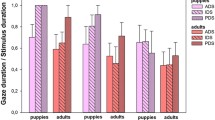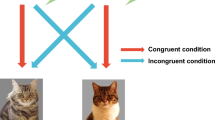Abstract
In contemporary western cultures, most humans talk to their pet companions. Speech register addressed to companion animals shares common features with speech addressed to young children, which are distinct from the typical adult-directed speech (ADS). The way dogs respond to dog-directed speech (DDS) has raised scientists’ interest. In contrast, much less is known about how cats perceive and respond to cat-directed speech (CDS). The primary aim of this study was to evaluate whether cats are more responsive to CDS than ADS. Secondarily, we seek to examine if the cats’ responses to human vocal stimuli would differ when it was elicited by their owner or by a stranger. We performed playback experiments and tested a cohort of 16 companion cats in a habituation–dishabituation paradigm, which allows for the measurement of subjects’ reactions without extensive training. Here, we report new findings that cats can discriminate speech specifically addressed to them from speech addressed to adult humans, when sentences are uttered by their owners. When hearing sentences uttered by strangers, cats did not appear to discriminate between ADS and CDS. These findings bring a new dimension to the consideration of human–cat relationship, as they imply the development of a particular communication into human–cat dyads, that relies upon experience. We discuss these new findings in the light of recent literature investigating cats’ sociocognitive abilities and human–cat attachment. Our results highlight the importance of one-to-one relationships for cats, reinforcing recent literature regarding the ability for cats and humans to form strong bonds.



Similar content being viewed by others
Data availability
Data are available from the corresponding author on request.
Code availability
Not applicable.
Change history
10 December 2022
A Correction to this paper has been published: https://doi.org/10.1007/s10071-022-01732-3
References
Ben-Aderet T, Gallego-Abenza M, Reby D, Mathevon N (2017) Dog-directed speech: why do we use it and do dogs pay attention to it? Proc R Soc B 284:20162429. https://doi.org/10.1098/rspb.2016.2429
Benjamin A, Slocombe K (2018) ‘Who’s a good boy?!’ Dogs prefer naturalistic dog-directed speech. Anim Cogn 21:353–364. https://doi.org/10.1007/s10071-018-1172-4
Bouma EMC, Reijgwart ML, Dijkstra A (2022) Family member, best friend, child or ‘just’ a pet, owners’ relationship perceptions and consequences for their cats. Int J Environ Res Public Health 19:193. https://doi.org/10.3390/ijerph19010193
Bradshaw J, Cameron-Beaumont C (2000) The signalling repertoire of the domestic cat and its undomesticated relatives. In: the domestic cat: The biology of its behaviour, 2nd edn. Cambridge University Press, Cambridge, pp 67–93
Burnham D, Kitamura C, Vollmer-Conna U (2002) What’s new, pussycat? On talking to babies and animals. Science 296:1435. https://doi.org/10.1126/science.1069587
Burnham D, Francis E, Vollmer-Conna U, Kitamura C, Averkiou V, Olley A, Nguyen M, Paterson C (1998) Are You My Little Pussy-Cat? Acoustic, Phonetic and Affective Qualities of Infant- and Pet-Directed Speech. 5th International Conference on Spoken Language Processing (ICSLP 98), Sydney
de Mouzon C, Gilbert C, Di-Stasi R, Leboucher G (2022) How’s my kitty? Acoustic parameters of cat-directed speech in human–cat interactions. Behav Process 203:1044755. https://doi.org/10.1016/j.beproc.2022.104755
Ellis SL (2009) Environmental enrichment: practical strategies for improving feline welfare. J Feline Med Surg 11(11):901–912
Eriksson M, Keeling LJ, Rehn T (2017) Cats and owners interact more with each other after a longer duration of separation. PLoS ONE 12(10):e0185599. https://doi.org/10.1371/journal.pone.0185599
Finka LR, Ward J, Farnworth MJ, Mills DS (2019) Owner personality and the wellbeing of their cats share parallels with the parent-child relationship. PLoS ONE 14(2):e0211862. https://doi.org/10.1371/journal.pone.0211862
Friard O, Gamba M (2016) BORIS: a free, versatile open-source event-logging software for video/audio coding and live observations. Methods Ecol Evol 7(11):1324–1330. https://doi.org/10.1111/2041-210X.12584
Galvan M, Vonk J (2016) Man’s other best friend: domestic cats (F. silvestris catus) and their discrimination of human emotion cues. Anim Cogn 19:193–205. https://doi.org/10.1007/s10071-015-0927-4
Gergely A, Faragó T, Galambos Á, Topál J (2017) Differential effects of speech situations on mothers’ and fathers’ infant-directed and dog-directed speech: an acoustic analysis. Sci Rep 7:13739. https://doi.org/10.1038/s41598-017-13883-2
Gergely A, Tóth K, Faragó T, Topál J (2021) Is it all about the pitch? Acoustic determinants of dog-directed speech preference in domestic dogs, Canis familiaris. Anim Behav 176:167–174. https://doi.org/10.1016/j.anbehav.2021.04.008
Hirsh-Pasek K, Treiman R (1982) Doggerel: motherese in a new context. J Child Lang 9:229–237. https://doi.org/10.1017/S0305000900003731
Hu Y, Hu S, Wang W, Wu X, Marshall FB, Chen X, Hou L, Wang C (2014) Earliest evidence for commensal processes of cat domestication. Proc R Soc B Biol Sci 111:116–120. https://doi.org/10.1073/pnas.1311439110
Humphrey T, Proops L, Forman J et al (2020) The role of cat eye narrowing movements in cat–human communication. Sci Rep 10:16503. https://doi.org/10.1038/s41598-020-73426-0
Jardat P, Lansade L (2022) Cognition and the human–animal relationship: a review of the sociocognitive skills of domestic mammals toward humans. Anim Cogn 25:269–384. https://doi.org/10.1007/s10071-021-01557-6
Jeannin S, Gilbert C, Amy M, Leboucher G (2017a) Pet-directed speech draws adult dogs’ attention more efficiently than adult-directed speech. Sci Rep 7:4980. https://doi.org/10.1038/s41598-017-04671-z
Jeannin S, Gilbert C, Leboucher G (2017b) Effect of interaction type on the characteristics of pet-directed speech in female dog owners. Anim Cogn 20:499–509. https://doi.org/10.1007/s10071-017-1077-7
Kaplan PS, Goldstein MH, Huckeby ER, Owren MJ, Cooper RP (1995) Dishabituation of visual attention by infant- versus adult-directed speech: effects of frequency modulation and spectral composition. Infant Behav Dev 18:209–223. https://doi.org/10.1016/0163-6383(95)90050-0
Lansade L, Trösch M, Parias C et al (2021) Horses are sensitive to baby talk: pet-directed speech facilitates communication with humans in a pointing task and during grooming. Anim Cogn 24:999–1006. https://doi.org/10.1007/s10071-021-01487-3
Lesch R, Kotrschal K, Schöberl I, Beetz A, Solomon J, Fitch WT (2019) Talking to dogs: companion animal-directed speech in a stress test. Animals 9(7):417. https://doi.org/10.3390/ani9070417
McComb K, Taylor AM, Wilson C, Charlton BD (2009) The cry embedded within the purr. Curr Biol 19:R507–R508. https://doi.org/10.1016/j.cub.2009.05.033
Merola I, Lazzaroni M, Marshall-Pescini S, Prato-Previde E (2015) Social referencing and cat–human communication. Anim Cogn 18:639–648. https://doi.org/10.1007/s10071-014-0832-2
Miklósi Á, Soproni K (2006) A comparative analysis of animals’ understanding of the human pointing gesture. Anim Cogn 9:81–93. https://doi.org/10.1007/s10071-005-0008-1
Miklósi Á, Pongrácz P, Lakatos G et al (2005) A comparative study of the use of visual communicative signals in interactions between dogs (Canis familiaris) and humans and cats (Felis catus) and humans. J Comp Psychol 119:179–186. https://doi.org/10.1037/0735-7036.119.2.179
Mitchell RW (2001) Americans’ talk to dogs: similarities and differences with talk to infants. Res Lang Soc Inter 34(2):183–210. https://doi.org/10.1207/S15327973RLSI34-2_2
Mitchell RW (2004) Controlling the dog, pretending to have a conversation, or just being friendly? Influences of sex and familiarity on Americans’ talk to dogs during play. Interaction Studies. Soc Behav Commun Biol Artif Syst 5(1):99–129. https://doi.org/10.1075/is.5.1.06mit
Mitchell RW, Edmonson E (1999) Functions of repetitive talk to dogs during play: control, conversation, or planning? Soc Anim 7(1):55–81. https://doi.org/10.1163/156853099X00167
Nibblett BM, Ketzis JK, GriggRoss EK (2015) Comparison of stress exhibited by cats examined in a clinic versus a home setting. Appl Anim Behav Sci 173:68–75. https://doi.org/10.1016/j.applanim.2014.10.005
Pereira DG, Afonso A, Melo Medeiros F (2015) Overview of Friedman’s test and post-hoc analysis. Commun Statistics-Simul Comput 44(10):2636–2653. https://doi.org/10.1080/03610918.2014.931971
Pongrácz P, Onofer DL (2020) Cats show an unexpected pattern of response to human ostensive cues in a series of A-not-B error tests. Anim Cogn 23:681–689. https://doi.org/10.1007/s10071-020-01373-4
Pongrácz P, Szapu JS, Faragó T (2019) Cats (Felis silvestris catus) read human gaze for referential information. Intelligence 74:43–52. https://doi.org/10.1016/j.intell.2018.11.001
Quaranta A, D’Ingeo S, Amoruso R, Siniscalchi M (2020) Emotion recognition in cats. Animals 10:1107. https://doi.org/10.3390/ani10071107
R Core Team (2021) R: A Language and environment for statistical computing. (Version 4.0) [Computer software]. Retrieved from https://cran.r-project.org. (R packages retrieved from MRAN snapshot 2021)
Ringrose CC (2015) Pitch change in dog-directed speech. Lifespans and Styles 1:28–35. https://doi.org/10.2218/ls.v1i0.2015.1181
Rowland CF, Pine JM, Lieven EVM, Theakston AL (2003) Determinants of acquisition order in wh-questions: Re-evaluating the role of caregiver speech. J Child Lang 30(3):609–635. https://doi.org/10.1017/S0305000903005695
Saito A, Shinozuka K (2013) Vocal recognition of owners by domestic cats (Felis catus). Anim Cogn 16:685–690. https://doi.org/10.1007/s10071-013-0620-4
Saito A, Shinozuka K, Ito Y et al (2019) Domestic cats (Felis catus) discriminate their names from other words. Sci Rep 9:5394. https://doi.org/10.1038/s41598-019-40616-4
Schötz S (2019) Paralinguistic information and biological codes in intra-and interspecific vocal communication: a pilot study of humans and domestic cats. In proceedings from FONETIK 2019 stockholm 67–72. https://doi.org/10.5281/zenodo.3246003
Sims VK, Chin MG (2002) Responsiveness and perceived intelligence as predictors of speech addressed to cats. Anthrozoös 15(2):166–177. https://doi.org/10.2752/089279302786992667
Stanton LA, Sullivan MS, Fazio JM (2015) A standardized ethogram for the felidae: a tool for behavioral researchers. Appl Anim Behav Sci 173:3–16. https://doi.org/10.1016/j.applanim.2015.04.001
Takagi S, Arahori M, Chijiiwa H et al (2019) Cats match voice and face: cross-modal representation of humans in cats (Felis catus). Anim Cogn 22:901–906. https://doi.org/10.1007/s10071-019-01265-2
Takagi S, Chijiiwa H, Arahori M, Saito A, Fujita K, Kuroshima H (2021) Socio-spatial cognition in cats: mentally mapping owner’s location from voice. PLoS ONE 16(11):e0257611. https://doi.org/10.1371/journal.pone.0257611
Tavernier C, Ahmed S, Houpt KA, Yeon SC (2020) Feline vocal communication. J Vet Sci. https://doi.org/10.4142/jvs.2020.21.e18
Topál J, Miklósi Á, Csányi V, Dóka A (1998) Attachment behavior in dogs (Canis familiaris): a new application of Ainsworth’s (1969) strange situation test. J Comp Psychol 112(3):219–229. https://doi.org/10.1037/0735-7036.112.3.219
Vitale KR (2022) The social lives of free-ranging cats. Animals 12(1):126. https://doi.org/10.3390/ani12010126
Vitale KR, Udell MAR (2019) The quality of being sociable: the influence of human attentional state, population, and human familiarity on domestic cat sociability. Behav Processes 158:11–17. https://doi.org/10.1016/j.beproc.2018.10.026
Vitale KR, Behnke A, Udell MAR (2019) Attachment bonds between domestic cats and humans. Curr Biol 29(18):864–865. https://doi.org/10.1016/j.cub.2019.08.036
Vitale Shreve K, Mehrkam L, Udell M (2017) Social interaction, food, scent or toys? A formal assessment of domestic pet and shelter cat (Felis Silvestris Catus) preferences. Behav Processes 141:322–328. https://doi.org/10.1016/j.beproc.2017.03.016
Xu N, Burnham D, Kitamura C, Vollmer-Conna U (2013) Vowel hyperarticulation in parrot-, dog- and infant-directed speech. Anthrozoös 26(3):373–380. https://doi.org/10.2752/175303713X13697429463592
Yeon SC, Kim YK, Park SJ, Lee SS, Lee SY, Suh EH, Lee HJ (2011) Differences between vocalization evoked by social stimuli in feral cats and house cats. Behav Process 87(2):183–189. https://doi.org/10.1016/j.beproc.2011.03.003
Acknowledgements
We would like to thank MARTIN SELLIER® for their financial support. Thanks to Caroline Gilbert for allowing this study to take place at EnvA and to Laëtitia Matray for helping in the recruitment of cat owners. Thanks to Chloé Tavernier and Alexandre Clasen for their participation in these experiments. Many thanks to owners and to their cats, who accepted to take part in this study.
Funding
This research was supported by French ministry of higher education and research (Ministère de l'Enseignement supérieur, de la Recherche et de l'Innovation) and MARTIN SELLIER® company, through the CIFRE program.
Author information
Authors and Affiliations
Corresponding author
Ethics declarations
Conflicts of interest
The authors declare that they have no conflict of interest.
Ethical approval
All procedures performed in the present study were in accordance with the ethical standards of the institutional and/or national research committee and with the 1964 Helsinki Declaration and its later amendments or comparable ethical standards. All applicable international, national and/or institutional guidelines for the care and use of animals were followed and all procedures performed in experiments involving animals were in accordance with the ethical standards of the institution at which the study was conducted. The study received the approval of the ethical committee of EnvA (COMERC), Saisine n 2018-10-24.
Consent to participate
Written informed consent was obtained from all animal owners.
Consent for publication
Written consent was obtained from all animal owners to include the image of their cat in the article.
Additional information
Publisher's Note
Springer Nature remains neutral with regard to jurisdictional claims in published maps and institutional affiliations.
The original online version of this article was revised due to change in the reference section.
Supplementary Information
Below is the link to the electronic supplementary material.
Rights and permissions
Springer Nature or its licensor (e.g. a society or other partner) holds exclusive rights to this article under a publishing agreement with the author(s) or other rightsholder(s); author self-archiving of the accepted manuscript version of this article is solely governed by the terms of such publishing agreement and applicable law.
About this article
Cite this article
de Mouzon, C., Gonthier, M. & Leboucher, G. Discrimination of cat-directed speech from human-directed speech in a population of indoor companion cats (Felis catus). Anim Cogn 26, 611–619 (2023). https://doi.org/10.1007/s10071-022-01674-w
Received:
Revised:
Accepted:
Published:
Issue Date:
DOI: https://doi.org/10.1007/s10071-022-01674-w




